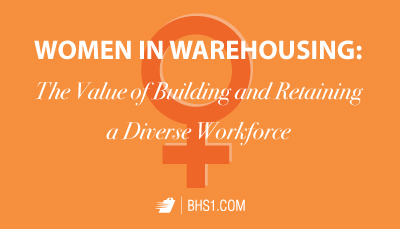We use cookies to make your experience better. To comply with the new e-Privacy directive, we need to ask for your consent to set the cookies. Learn more.
Women in Warehousing: The Value of Building and Retaining a Diverse Workforce
March is National Women's History Month, but that's not the only reason that this is a great time to talk about women in warehousing. We're also at a crucial point in the development of logistics workforces, which aren't keeping up with the industry's growth. If businesses can't attract new employees, we'll start to have serious problems keeping up with the seemingly ever-growing demand for the movement of goods from one place to another.
Women can help fill these roles at every level. And it isn't just forklift operators and order pickers and packers that logistics providers will need to hire. The entire supply chain is struggling with personnel shortages. We need to attract and retain the next generation of freight agents, inventory managers, administrators, and supply chain analysts soon to avoid slowing down the entire economy.
The drive to hire and retain women in warehousing positions should be a big part of that effort. Here are a few reasons why:

-
As of 2016, the latest figures available from the Bureau of Labor Statistics, only 31.6 percent of the employees in the warehousing and storage industry were women. As we seek to expand our workforces, it makes sense to reach out to groups who have historically been underrepresented in the field.
-
Gender diversity in the workplace produces new perspectives, leading to better solutions and a greater understanding of the client base.
-
Research suggests that greater gender diversity is directly associated with increased profits. In fact, a study from McKinsey & Company found that for each 10-percent boost in gender diversity, companies across industries realized a profit increase of 2 to 4 percent.
-
A 2013 survey from the Center for Talent Innovation further supports the value of gender diversity in the workplace. The survey asked companies with more and fewer women in senior management positions whether they had improved market share in the previous year. Nearly half of the companies with more diversity at the top had accomplished that goal. Only 33 percent of the companies with less diverse leadership gained more market share.
Some say that automation will replace warehouse workers soon enough, so why worry about rebuilding a workforce that is rapidly retiring and aging out of material handling tasks? This claim misunderstands our moment in history.
As the 2018 Third-party Logistics Study reports, "Although it may seem like increased automation will decrease the need for companies to invest in employees, the opposite is true. Technology will help employees recognize greater potential and address certain tasks so that talent can push further, but it is human talent that is the key factor in defining and applying innovation."
Women in warehousing will make up a large part of that talent pool in the coming years.
References:
"Labor Force Statistics from the Current Population Survey: Household Data Annual Averages." BLS. Bureau of Labor Statistics, 2016. Web. 13 Dec. 2017.
Langley, John. "2018 Third-Party Logistics Study." 3PLStudy. Infosys, 2017. Web. 13 Dec. 2017.
Morley, Hugh. "World Bank sounds alarm on logistics worker shortage." JOC. The Journal of Commerce, 8 Sept. 2017. Web. 13 Dec. 2017.
Ralph, Oliver and Laura Noonan. "Diversity brings boost to profitability." FT. The Financial Times Ltd, 4 Apr. 2017. Web. 13 Dec. 2017.
